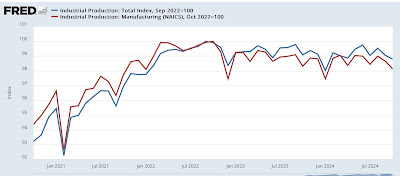- by New Deal democrat
Today in the US is officially Veterans Day, in which we salute the service of all veterans. But it started - and still continues in some countries - as Remembrance Day, a somber memorial to all those who were killed in World War 1, which ended on November 11, 1918. That is more how today feels to me now.
In behavioral economics, Hymen Minsky eludicated the brilliant theory that “stability breeds instability.” Basically, the more successful the guardrails erected to protect an economic system, the more players will try to take advantage of testing those guardrails until eventually, they give way catastrophically.
World War 1 was a demonstration that “stability breeds instability” applies to political systems as well.
In 1914 Europe had experienced almost a full century of relative peace, following the end of the Napoleonic wars. The only major conflict on the continent during that time was the Franco-Prussian war, which lasted only 6 months. During that period of stability Europe continued to make progress in science and industrialization, probably reaching the zenith of its relative global power as the 20th century dawned.
Human nature being what it is, as time progressed and the wars were forgotten, the monarchs made ever more aggressive military noises, “pushing the envelope” of the European system, ultimately rooting for its collapse it what was sure to be a brief triumphant march to victory for [insert empire’s name here].
Not so much.
In the aftermath of World War 2, primarily but not exclusively under the leadership of the US, a new global political and economic system was erected, including the United Nations, NATO, the European Common Market (now the EU), and US allies Japan and South Korea in Asia.
The Cold War between the USSR and US was conducted within this framework. There were some terrible regional conflicts, e.g., the Korean, Vietnam, and Afghanistan wars, but these were contained. With the exception of the Cuban missile crisis, there never was a direct military superpower confrontation. Even things like the Berlin airlift was carefully scripted to avoid escalation.
World War 2 ended almost 80 years ago. A majority of people alive today do not remember Korea, Vietnam, the first Gulf War, or even the collapse of communism in 1989-91.
And in places like Ukraine and Taiwan, we see the escalating “pushing of the envelope.” Meanwhile the US has just elected a President who has made it clear he would like the US to pull out of NATO.
I firmly believe that we are witnessing the final collapse of the post-WW2 order.
And so today, Remembrance Day, I have thought about Vera Brittain’s sad memoir of World War 1, “Testament of Youth.”
In the most recent TV adaptation, the first scene is Brittain swimming in a pond with her brother and three of his school chums. She falls in love with one of them, Roland, and by the time he leaves for the front they are fiancées.
And one after another, all 4 die.
On November 11, 1918, Brittain, now a nurse, walks zombielike down a London street as around her people rejoice at 11 a.m., the precise time of the Armistice. The adaptation concludes with her once again going for a swim in that same pond, all alone; her brother, her fiancée, and the two other young men all dead and gone unto eternity.
A few days ago there was a comic strip, maybe xkcd, that consisted of two panels, the first of which said “Those who do not remember their history are doomed to repeat it.”
The second panel says, “And those who *do* remember their history are doomed to watch helplessly as others repeat it.”
On this Remembrance Day I somberly contemplate the end of the post-WW2 order and the human price that will be paid.






















